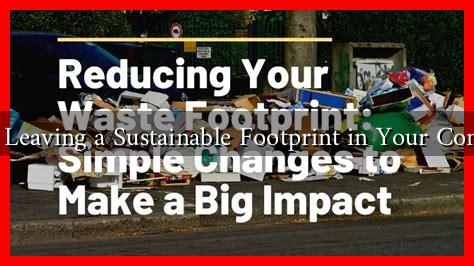-
Table of Contents
Tips for Leaving a Sustainable Footprint in Your Community
As global awareness of environmental issues grows, individuals are increasingly seeking ways to contribute positively to their communities while minimizing their ecological impact. Leaving a sustainable footprint is not just about personal choices; it involves engaging with and uplifting the community around you. Here are some practical tips to help you make a difference.
1. Embrace Local and Sustainable Products
One of the most effective ways to support sustainability is by choosing local and sustainable products. This not only reduces carbon emissions associated with transportation but also supports local economies.
- Farmers’ Markets: Regularly visit local farmers’ markets to purchase fresh produce. This supports local farmers and reduces the carbon footprint associated with transporting food.
- Local Artisans: Buy handmade goods from local artisans instead of mass-produced items. This helps sustain local craftsmanship and reduces waste.
- Community Supported Agriculture (CSA): Join a CSA program to receive seasonal produce directly from local farms.
2. Reduce, Reuse, and Recycle
The three R’s—reduce, reuse, and recycle—are fundamental principles of sustainability. Implementing these practices can significantly decrease waste in your community.
- Reduce: Be mindful of your consumption. Opt for products with minimal packaging and avoid single-use items.
- Reuse: Find creative ways to repurpose items instead of discarding them. For example, glass jars can be used for storage or as planters.
- Recycle: Familiarize yourself with your community’s recycling guidelines to ensure you are recycling correctly. According to the EPA, recycling and composting prevented the release of 186 million metric tons of carbon dioxide equivalent into the air in 2018.
3. Get Involved in Community Clean-Up Initiatives
Participating in community clean-up events is a hands-on way to contribute to a cleaner environment. These initiatives not only beautify your community but also foster a sense of camaraderie among residents.
- Organize or Join Clean-Up Days: Collaborate with local organizations to organize clean-up days in parks, beaches, or neighborhoods.
- Adopt a Spot: Consider adopting a local area that you can regularly maintain, ensuring it remains clean and inviting.
- Engage Youth: Involve schools and youth groups in clean-up efforts to instill a sense of responsibility towards the environment from a young age.
4. Advocate for Sustainable Practices
Being an advocate for sustainability can amplify your impact. Use your voice to promote eco-friendly practices within your community.
- Attend Town Hall Meetings: Engage with local government by attending meetings and advocating for sustainable policies, such as improved public transportation or green spaces.
- Start a Petition: If you see a need for change, such as banning plastic bags or promoting renewable energy, start a petition to gather community support.
- Educate Others: Host workshops or informational sessions to educate your community about sustainability and its benefits.
5. Support Renewable Energy Initiatives
Transitioning to renewable energy sources is crucial for reducing carbon footprints. Support initiatives that promote clean energy in your community.
- Community Solar Projects: Participate in or advocate for community solar projects that allow residents to benefit from solar energy without needing to install panels on their homes.
- Energy Efficiency Programs: Encourage local businesses and residents to participate in energy efficiency programs that reduce energy consumption.
- Incentives for Renewable Energy: Support policies that provide incentives for the installation of solar panels and wind turbines.
Conclusion
Leaving a sustainable footprint in your community is a multifaceted endeavor that requires commitment and action. By embracing local products, reducing waste, participating in clean-up initiatives, advocating for sustainable practices, and supporting renewable energy, you can make a significant impact. Remember, every small action contributes to a larger movement towards sustainability. Together, we can create healthier, more vibrant communities for future generations. For more information on sustainable practices, visit EPA’s Sustainable Management of Food.

